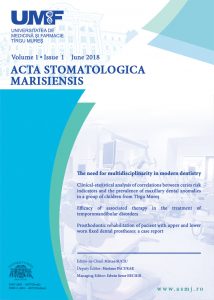Pathological tooth wear occurs in young patients. The rehabilitation of these teeth must be performed accurately, considering the occlusal relationships and the correct distribution of the masticatory forces. The therapeutic approach must be as minimally invasive as possible.
In this case presentation, six palatal veneers were realized for the aesthetic and functional rehabilitation of a young patient’s upper frontal teeth. The restorations were made on refractory casts, from feldspathic ceramics, allowing a proper esthetic. The occlusal rehabilitation involves the mounting of the casts in a semi-adjustable articulator. The six veneers were adapted functionally by using the Bio-Art A7 Plus articulator. Due to the adhesive techniques and the existing interocclusal space at this level, the teeth’s preparation was limited to the enamel. The deep chamfer was placed equigingivally. During the try-in of the restorations, the esthetic evaluation was done. The adhesive technique was used to bond the veneers to the tooth surfaces. After the cementation, the esthetical results were evaluated. During the prosthodontic treatment, T-Scan III digital analysis was performed to detect occlusal problems, to establish the treatment directions, and to evaluate the results.
Conclusions: The use of the adhesively bonded feldspathic palatal veneers allows a successful esthetic and functional rehabilitation. The digital occlusal analysis, realized using the T-Scan system, improves the prosthodontic treatment quality and durability.
Kinga Mária Janosi 1, Aurița Albu 1, Adriana Crăciun 1, Diana Cerghizan 1
1 George Emil Palade University of Medicine, Pharmacy, Science, and Technology of Targu Mures, Romania
1 George Emil Palade University of Medicine, Pharmacy, Science, and Technology of Targu Mures, Romania

Comments are closed.